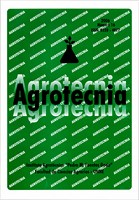Comportamiento higiénico y grooming, métodos de estudio de varroosis en apiarios de Corrientes
DOI:
https://doi.org/10.30972/agr.347270Palabras clave:
Apis mellifera, Varroa destructor, infestación por ácaros, pisos técnicos, Nordeste ArgentinoResumen
El parásito Varroa destructor es el principal responsable de la muerte de colonias de abejas registradas en Argentina. Sin embargo, algunos linajes de Apis mellifera parecen tener cualidades, que le brindan mayor resistencia a la parasitosis respecto de otras colonias que son gravemente afectadas, hasta el colapso y la muerte. El comportamiento higiénico, la alta capacidad de acicalamiento o grooming y la enjambrazón, pueden ser algunas de esas características. El objetivo fue estudiar el comportamiento higiénico y grooming en colonias de A. mellifera y su relación con el porcentaje de infestación de V. destructor. La metodología fue: 1. Selección de apiarios. 2. Evaluación de la infestación con Varroa en abejas adultas y en cría. 3. Determinación de capacidad de limpieza de la población de abejas y 4. Estimación del comportamiento de grooming de la población de abejas. Respecto al comportamiento higiénico evaluado en las colmenas seleccionadas, se observó que las abejas de la zona presentan alto porcentaje de eficiencia en remoción de la cría muerta. Los valores porcentuales de varroa desprendida por acción de grooming fue alto en las colmenas del ensayo C1 y C14 y alcanzó el 51% en la C12. Las poblaciones de abejas estudiadas presentan características sanitarias que las distinguen de abejas de otras regiones del país: 1- Muestran tolerancia a los porcentajes de infestación con varroa y 2- Expresan alto comportamiento higiénico y grooming. Estas cualidades, sumadas a estudios de morfometría alar, podrían sentar las bases para diferenciar y caracterizar las abejas del nordeste argentino.
Descargas
Publicado
Cómo citar
Número
Sección
Licencia

Esta obra está bajo una licencia internacional Creative Commons Atribución-NoComercial-CompartirIgual 4.0.



